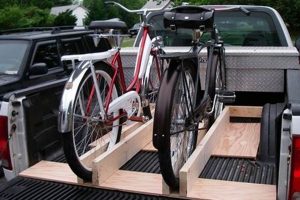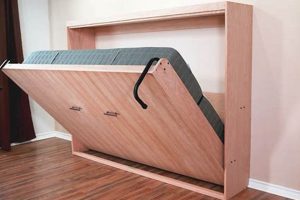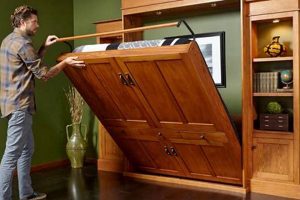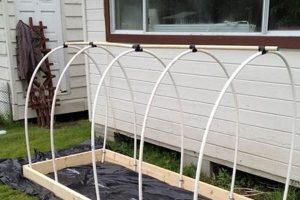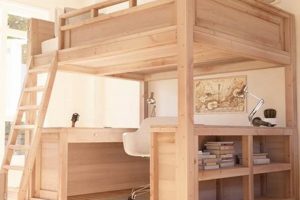A do-it-yourself wall bed configuration utilizing components sourced from a Swedish furniture retailer represents a practical solution for space optimization, especially in dwellings with limited square footage. This approach combines the adaptability of readily available, mass-produced furniture with the customization inherent in self-assembly and modification.
The appeal of such projects lies in their potential for cost-effectiveness compared to professionally installed alternatives. Furthermore, integrating a fold-away bed unit enhances the functionality of rooms, allowing them to serve multiple purposes, such as a home office by day and a bedroom at night. The availability of affordable and modular parts from established retailers democratizes access to space-saving furniture solutions.
Subsequent sections will explore the critical considerations for undertaking a project of this nature, including planning, material selection, safety precautions during assembly and installation, and potential modifications to enhance aesthetics and functionality. The focus will remain on providing guidance for constructing a safe and reliable fold-away bed system.
Construction Guidance
The successful implementation of a fold-away bed, incorporating components from a major furniture retailer, necessitates meticulous planning and execution. Prioritize safety and structural integrity throughout the process.
Tip 1: Precise Measurement is Paramount. Accurately measure the available space and the dimensions of all components before initiating construction. Discrepancies can lead to instability and potential hazards.
Tip 2: Reinforce Structural Weak Points. The particleboard construction common in flat-pack furniture may require additional bracing. Consider adding wood supports to key joints and load-bearing areas.
Tip 3: Employ High-Quality Fasteners. Replace the provided hardware with stronger alternatives, such as heavy-duty screws and bolts. This is especially crucial for anchoring the frame to the wall.
Tip 4: Implement a Robust Locking Mechanism. Ensure the bed is securely locked in both the upright and lowered positions. A reliable locking system prevents accidental opening or closing.
Tip 5: Prioritize Wall Anchoring. Utilize appropriate wall anchors based on the wall’s construction (drywall, plaster, concrete). Consult with a hardware professional to determine the most suitable type.
Tip 6: Test the Mechanism Thoroughly. Before regular use, repeatedly test the raising and lowering mechanism to identify any potential issues or points of friction.
Tip 7: Account for Mattress Weight. Choose a mattress that falls within the weight specifications of the lifting mechanism. Exceeding the weight limit can compromise the system’s functionality and safety.
Adhering to these guidelines will contribute to a safer, more durable, and ultimately more satisfying result. Remember that structural integrity is paramount when dealing with a large, heavy object that will be regularly moved.
The following section will address aesthetic considerations and customization options for the fold-away bed project.
1. Space Optimization
Space optimization, in the context of domestic environments, refers to the maximization of usable area within a given footprint. The construction of a fold-away bed from readily available furniture components directly addresses this need, particularly in dwellings characterized by limited square footage.
- Multifunctional Room Utilization
A fold-away bed allows a single room to serve multiple purposes. For instance, a home office can be quickly converted into a guest bedroom. This adaptability is crucial in apartments or smaller homes where dedicating entire rooms to specific, infrequent uses is impractical. The ability to reconfigure a space rapidly enhances its overall utility.
- Vertical Space Exploitation
Traditional beds occupy a significant horizontal area. A wall-mounted bed, when not in use, frees up this floor space. By utilizing vertical space, the room feels less cluttered and more open. The mechanism of retracting the bed against the wall allows for the reclaimed area to be used for other activities, such as exercise or play.
- Storage Integration
Many fold-away bed designs incorporate integrated storage solutions. Cabinets, shelves, or drawers can be built around the bed frame, providing additional space for clothing, books, or other personal belongings. This consolidation of storage and sleeping arrangements further optimizes the available area.
- Aesthetic Versatility
When stowed, the front panel of the fold-away bed can be customized to blend seamlessly with the surrounding dcor. It can be painted, wallpapered, or adorned with decorative panels to create a visually appealing and unobtrusive element. This aesthetic versatility allows the space to maintain a cohesive and uncluttered appearance even when the bed is not in use.
The integration of readily available components into a fold-away bed design offers a practical means of achieving significant space optimization within residential environments. By enabling multifunctional room utilization, exploiting vertical space, integrating storage, and offering aesthetic versatility, such projects directly address the challenges posed by limited living areas.
2. Component Compatibility
Component compatibility is a crucial factor in the success of a self-assembled wall bed utilizing furniture retailer elements. The extent to which various parts integrate, both structurally and functionally, directly impacts the bed’s stability, safety, and overall usability. Careful consideration of material properties, dimensions, and load-bearing capabilities is essential.
- Frame Integration
The integration of the bed frame with the surrounding cabinet structure requires precise measurements and, often, modifications. The standard dimensions of beds and cabinet units may not align perfectly, necessitating alterations to ensure a secure and level sleeping platform. This can involve trimming panels, adding support structures, or creating custom brackets. Failure to adequately address frame integration compromises the bed’s stability.
- Lifting Mechanism Compatibility
The chosen lifting mechanism must be appropriately sized and rated for the combined weight of the bed frame and mattress. Incompatibility can lead to operational difficulties, accelerated wear and tear, or, in severe cases, mechanism failure resulting in potential injury. Thoroughly review the manufacturer’s specifications for weight capacity and mounting requirements before installation.
- Hardware Coordination
The hardware used to connect the various components (screws, bolts, hinges, etc.) must be of sufficient strength and type to withstand the stresses imposed during operation. Substituting inadequate hardware, particularly in load-bearing areas, can compromise the structural integrity of the assembly. Using appropriate hardware specifically designed for the materials being joined is critical.
- Mattress Dimensions and Weight
The mattress must fit within the designated frame dimensions and adhere to the weight limitations specified for the lifting mechanism. An oversized or excessively heavy mattress can impede the folding action, strain the mechanism, or create an unbalanced load distribution. Careful mattress selection ensures smooth operation and prolonged mechanism lifespan.
Successful construction of a fold-away bed from widely available components hinges on meticulous attention to component compatibility. Addressing these challenges proactively through careful planning, precise measurements, and appropriate material selection is paramount for a safe and functional result. These considerations are central to ensuring a cost-effective and durable space-saving solution.
3. Structural Reinforcement
Structural reinforcement is a critical element in the construction of a fold-away bed utilizing components from a major furniture retailer. The inherent design and material properties of flat-pack furniture necessitate additional strengthening to ensure the long-term stability and safety of the final assembly. The following details the key facets of reinforcement.
- Frame Bracing
The frame, typically constructed from particleboard or MDF, often requires additional bracing to withstand the stresses associated with repeated folding and unfolding. This can be achieved through the strategic placement of wood or metal supports along the frame’s perimeter and at key stress points. Examples include reinforcing corners with metal brackets or adding a solid wood apron to the bed base. Inadequate bracing can lead to frame warping, joint failure, and eventual collapse.
- Joint Strengthening
The joints connecting the various frame components are vulnerable to loosening over time, particularly under the weight of a mattress and occupants. Reinforcing these joints with wood glue, screws, or metal fasteners beyond what is provided in the original assembly instructions is essential. Dowel joints, common in flat-pack furniture, may benefit from supplemental screw reinforcement. Failure to adequately strengthen joints results in instability and potential separation of components.
- Wall Anchoring Enhancement
The method of anchoring the bed frame to the wall is paramount for safety. The provided hardware may not be sufficient to withstand the forces exerted on the unit during operation. Utilizing heavy-duty wall anchors appropriate for the wall’s construction (drywall, plaster, concrete) is critical. Furthermore, reinforcing the attachment points on the bed frame itself provides a more secure connection. Insufficient anchoring can lead to the bed detaching from the wall, posing a significant safety hazard.
- Lifting Mechanism Support
The lifting mechanism, responsible for raising and lowering the bed, exerts considerable stress on the surrounding frame. Reinforcing the areas where the mechanism attaches to the frame is vital to prevent deformation or failure. This can involve adding solid wood backing plates or metal reinforcement brackets. A compromised lifting mechanism support structure can render the bed unusable and potentially dangerous.
The integration of these reinforcement strategies is essential for transforming readily available furniture components into a safe and reliable fold-away bed system. Without adequate structural enhancements, the inherent limitations of the original materials and construction methods pose a significant risk of failure, undermining the practicality and safety of the entire project.
4. Safe Locking Mechanism
The integration of a secure locking mechanism is paramount in the construction of a fold-away bed system utilizing components from a major furniture retailer. This is not merely a desirable feature but a fundamental safety requirement. The absence of a reliable locking system introduces the potential for uncontrolled deployment of the bed, leading to property damage or, more critically, serious personal injury. The weight of a lowered bed, coupled with the leverage inherent in the folding design, presents a significant hazard if the bed were to unexpectedly swing open from a stowed position.
The practical significance of a robust locking mechanism extends beyond preventing accidents. It provides peace of mind to the user, ensuring that the bed remains securely stowed when not in use. Consider a small apartment where the fold-away bed is situated in a multi-purpose living area. Without a reliable lock, the risk of accidental opening could impede daily activities, limit available space, and create a constant source of anxiety. A well-designed locking system eliminates this concern, allowing the space to be used with confidence and freedom.
In summary, the safe locking mechanism constitutes a critical component of any fold-away bed endeavor using ready-to-assemble furniture. The failure to implement a system of appropriate strength and reliability negates the space-saving benefits of the design, replacing them with a substantial safety risk. The consequences of neglecting this aspect can range from property damage to severe injury, underscoring its absolute necessity in such projects.
5. Secure Wall Mounting
Secure wall mounting represents a foundational element in the successful execution of a do-it-yourself fold-away bed project using components from a major furniture retailer. The structural integrity and safe operation of such a system are intrinsically linked to the strength and reliability of the wall attachment. Improper wall mounting constitutes a critical safety hazard, potentially leading to detachment, collapse, and consequential injuries. The forces exerted on the wall anchors during the raising and lowering of the bed, coupled with the static weight of the bed frame, mattress, and any occupants, demand a robust and properly installed anchoring system. For instance, a poorly anchored unit in a home with young children presents a significant risk; the unintended collapse of the bed poses an immediate and severe threat.
The selection of appropriate wall anchors depends on the wall’s composition (drywall, plaster, concrete, wood studs). Drywall anchors, while suitable for lighter loads, are generally inadequate for supporting a fully assembled fold-away bed. Concrete or masonry walls require specialized anchors designed to grip the solid material. Furthermore, simply relying on existing wall studs may not be sufficient, as the spacing and load-bearing capacity of the studs must be carefully assessed. It is often necessary to reinforce the wall structure with additional lumber or metal bracing to provide a secure and stable attachment point. A professional consultation is highly recommended to evaluate the wall’s load-bearing capacity and advise on the appropriate anchoring method.
In conclusion, secure wall mounting is not merely a step in the assembly process; it is a prerequisite for the safe and functional operation of a fold-away bed constructed with readily available furniture components. The selection of appropriate anchors, reinforcement of the wall structure, and adherence to best practices in installation are all essential. Prioritizing secure wall mounting minimizes the risk of structural failure and ensures the long-term usability of the space-saving solution. Neglecting this aspect fundamentally undermines the value and safety of the project.
6. Customization Options
The incorporation of customization options within a fold-away bed project utilizing components from a major furniture retailer significantly enhances its practicality and aesthetic integration. The inherent modularity and adaptability of this approach offer a wide range of possibilities beyond the standardized configurations provided by pre-fabricated solutions. This flexibility allows the user to tailor the final product to specific spatial constraints, functional requirements, and stylistic preferences. For example, standard units may not accommodate non-standard mattress sizes or integrate seamlessly with existing storage systems, while a customized project can address these limitations effectively.
Customization extends beyond mere dimensional adjustments. The selection of finishes, hardware, and integrated storage elements provides an opportunity to create a cohesive design that complements the surrounding environment. A basic frame could be augmented with custom-built cabinetry, shelving, or lighting fixtures. Furthermore, the front panel of the folded bed can be designed to mimic a built-in bookcase or display artwork, effectively concealing its primary function. This blending of form and function transforms a utilitarian space-saving device into an integral element of the room’s overall design. A homeowner might, for instance, match the panel’s finish to existing kitchen cabinets to maintain a consistent aesthetic in a studio apartment.
Ultimately, the degree of customization achievable within a fold-away bed project, employing components from readily available sources, hinges on the user’s skill level, available resources, and creative vision. While the standardized parts provide a cost-effective foundation, the addition of personalized elements elevates the project from a mere space-saving solution to a tailored and aesthetically pleasing element within the living space. Overcoming the challenges of integrating disparate elements requires careful planning and execution, but the resulting product can offer a unique combination of functionality, style, and cost-effectiveness.
7. Cost-Effectiveness
Cost-effectiveness is a primary driver for individuals considering a self-assembled fold-away bed using components from a major furniture retailer. This approach seeks to balance functionality and affordability, offering a potential alternative to higher-priced, professionally installed systems.
- Reduced Labor Costs
One of the most significant cost savings derives from the elimination of professional installation fees. The individual undertaking the project assumes the labor burden, relying on their own time and skills. This is particularly advantageous for those with existing carpentry or assembly experience. However, it is essential to account for the value of one’s own time and the potential costs associated with errors or rework. Professional installation, while more expensive upfront, may ultimately be more cost-effective if extensive modifications or specialized skills are required.
- Modular Component Sourcing
Major furniture retailers offer a wide range of modular components that can be adapted for use in a fold-away bed system. These components, often mass-produced and readily available, represent a lower-cost alternative to custom-fabricated parts. The ability to select only the necessary elements, rather than purchasing a complete pre-assembled unit, further contributes to cost savings. However, it is crucial to ensure compatibility between the chosen components and to account for any additional materials or hardware required for assembly and reinforcement.
- Material Cost Management
The choice of materials directly impacts the overall cost of the project. Opting for lower-cost materials, such as particleboard or MDF, can significantly reduce expenses. However, it is essential to consider the trade-offs in terms of durability and longevity. Reinforcing these materials, as previously discussed, is often necessary to compensate for their inherent weaknesses. Balancing material cost with the need for structural integrity is a critical consideration in maximizing cost-effectiveness.
- Avoidance of Custom Design Fees
Engaging a designer to create a custom fold-away bed system can incur significant design fees. A self-assembled project, utilizing readily available components, eliminates this expense. However, it also requires the individual to assume responsibility for the design and planning aspects of the project. Thorough research, detailed planning, and careful attention to measurements are essential to avoid costly errors or miscalculations.
In summary, the cost-effectiveness of a self-assembled fold-away bed employing components from a major furniture retailer hinges on a careful assessment of labor costs, material selection, component compatibility, and the avoidance of design fees. While the potential for significant cost savings exists, it is essential to balance these savings with the need for structural integrity, functionality, and long-term durability. A well-planned and executed project can offer a cost-effective alternative to professionally installed systems, while a poorly executed project may ultimately prove to be more expensive in terms of time, materials, and potential safety hazards.
Frequently Asked Questions
This section addresses common inquiries and misconceptions regarding the construction of a fold-away bed utilizing parts sourced from a major furniture retailer.
Question 1: Is it possible to construct a safe and reliable fold-away bed system solely from flat-pack furniture components?
While feasible, it necessitates significant structural reinforcement and adherence to stringent safety protocols. Relying exclusively on the original components is generally insufficient to ensure long-term stability and safety. Additional materials and hardware are almost always required.
Question 2: What are the primary safety concerns associated with such a project?
Key safety concerns include inadequate wall anchoring, potential for the bed frame to collapse due to insufficient structural support, and the risk of uncontrolled deployment due to a faulty or absent locking mechanism. These issues must be addressed proactively throughout the design and construction process.
Question 3: What specific modifications are typically required to enhance the structural integrity of the bed frame?
Common modifications involve adding wood or metal supports to reinforce joints, using higher-quality fasteners, and strengthening the points where the lifting mechanism attaches to the frame. The specific modifications will vary depending on the design and materials used.
Question 4: What type of wall anchors are recommended for securing the bed frame to the wall?
The type of wall anchors depends on the wall’s composition. Concrete or masonry walls require specialized anchors designed for these materials. For wood-framed walls, heavy-duty lag screws, ideally anchored into wall studs, are recommended. Drywall anchors are generally insufficient for the weight and stress involved.
Question 5: How can the risk of accidental bed deployment be minimized?
A robust locking mechanism is essential. This mechanism should securely hold the bed in the stowed position and be easily engaged and disengaged. Redundant locking systems, incorporating multiple points of engagement, provide an additional layer of safety.
Question 6: Does this type of project require specialized tools or skills?
While basic carpentry skills and common tools (drill, saw, level, etc.) are required, a project of this nature may also necessitate specialized tools for precise cutting, drilling, or fastening. A thorough understanding of structural principles and building codes is also beneficial.
The information presented above underscores the importance of careful planning, execution, and adherence to safety guidelines when constructing a fold-away bed using readily available furniture components. The simplification of information here will help you digest the process.
The next section will address potential legal considerations associated with constructing and installing this type of bed.
Conclusion
The preceding discussion has explored the multifaceted aspects of constructing a fold-away bed system, a “diy murphy bed ikea” project, utilizing components sourced from a major furniture retailer. Key considerations encompass structural reinforcement, secure wall mounting, implementation of a reliable locking mechanism, and meticulous attention to component compatibility. A lack of due diligence in any of these areas can compromise the safety and long-term viability of the project.
The pursuit of a space-saving solution must be tempered by a commitment to safety and structural integrity. While the lure of cost-effectiveness and customization is undeniable, potential constructors must prioritize the acquisition of sufficient knowledge, skills, and resources to ensure a successful and, above all, safe outcome. Prudence dictates careful assessment of individual capabilities and, when necessary, the engagement of qualified professionals to mitigate potential risks.


